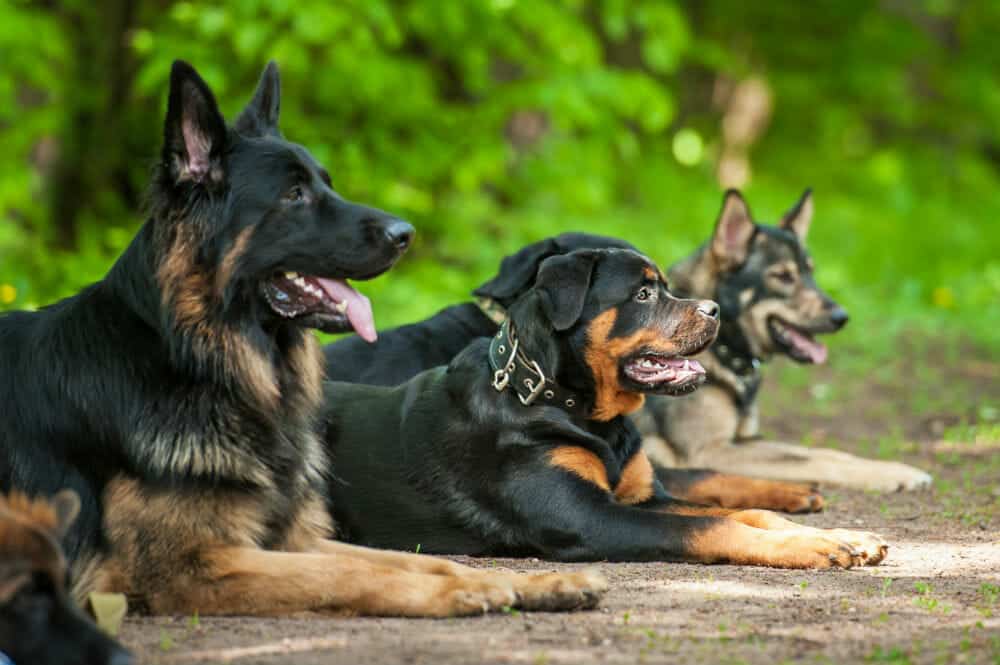With the recent surge in home invasions, a lot of people have home security on their minds. There are several home security options to choose from, and most of them will increase both your physical safety and your peace of mind.
That being said, family protection dogs are one of the best options for a lot of people. These dogs are trained to protect you and your family.
Keep in mind:
These aren’t just violent attack dogs. Rather, protection dogs are trained to calmly assess potentially dangerous situations. They aren’t “violent” so much as they’re protective.
When a protection dog joins your family, your safety and that of your family become its primary concern. These awesome animals will attack on command, and they’ll even attack on their own if the situation demands it.
In almost all cases, a protection dog’s actions are primarily driven by their desire to keep their family safe. For this reason, having one of these amazing dogs around is one of the best ways to protect your family’s well-being.
Is My Dog a Protection Dog?
There are a wide variety of breeds that can potentially make great protection dogs. There isn’t one dog breed that’s used exclusively for protection, however, German Shepherds are one of the most common protection dog breeds.
Additionally, because German Shepherds are so good at this line of work, they’re one of the most common dog breeds used in K9 squads by law enforcement.
Ideally, a protection dog should be large, strong, loyal, and, obviously, protective. Quite often protection dog breeds enjoy games such as fetch, and they’ll be particularly suspicious when it comes to strangers.
Protection dogs require regular care and training to keep their health and their protective skills up to par. A lot goes into this, so let’s talk about a few of the things that you can do to keep your protection dog happy and healthy.
Keeping Up with Your Protection Dog’s Training
When it comes to training your protection dog, you must begin training at the right age.
Several different breeds can be trained as protection dogs, and the proper training age can vary from breed to breed. The vast majority of protection dog breeds should start training when they’re around 49 days old.
 The biggest outstanding exception is the German Shepherd, which can be trained about ten days earlier.
The biggest outstanding exception is the German Shepherd, which can be trained about ten days earlier.
For the best results:
You should have a professional trainer work with your protection dog. Most people simply don’t have the time or expertise necessary to give their dog the training that it needs.
However, there are things that you, as the protection dog owner, can do to aid the effectiveness of their training. When interacting with your protection dog, use positive reinforcement!
Positive reinforcement is key when it comes to training your protection dog, as it will allow them to calmly assess potentially dangerous situations.
How to Keep a Protection Dog Healthy and Fit
For your protection dog to be an effective guardian, it’s important that you keep them in good shape. That means playing and exercising with them daily!
Protection dogs do, however, tend to get tired pretty easily. With that in mind, you don’t want to overwork your playful protector. Additionally, you’ll want to make sure that you’re playing and exercising with your protection dog in a healthy way.
Specifically, you should be careful when it comes to your dog’s joints. Large, muscular dogs tend to need extra attention in that area. An important thing to consider is how to keep your dog’s hip healthy. To keep their joints healthy, keep your dog from jumping on and off furniture and avoid stairs whenever possible.
Several exercises can be enjoyable for both you and your protection dog. For instance, protection dogs usually love a good game of frisbee or fetch.
Additionally, guardian dogs enjoy taking walks, and they benefit from them. So no matter how much you want to sit down and watch TV when you get home, consider incorporating healthy dog habits into your evening and give your furry pal the attention that he needs first.
After all, your well-being is this animal’s primary concern. It’s important to repay the favor by keeping your protection dog happy and healthy. If you want to learn more about how to play with, exercise, and train your protection dog, check out the article published by Purina.
Maintaining a Healthy Diet for Your Dog

Maintaining a nutritious diet for a protection dog is essential to keep your furry friend is happy and healthy. This means feeding your dog with healthy dog food and treats.
Guard dogs can be expensive, and the expenses don’t stop after the initial purchase. Don’t buy your guardian dog the cheap stuff! This animal is tasked with protecting your life, so an investment in healthy dog food is an investment in your safety.
With only a few exceptions:
Don’t feed your protection dog human food. Many human foods are toxic to dogs. Specifically, keep your dog away from grapes, raisins, chocolates, avocados, yeast dough, nuts, alcohol, onions, garlic, chives, the ingredient xylitol, and sugar-free gum.
There are, however, some healthy human foods for dogs. Dogs love baby carrots, unsalted green beans, and small slices of cooked sweet potatoes, and these foods are good for them! Just make sure those cooked sweet potatoes aren’t too hot.
Additionally, it’s important to feed your protection dog the correct amount of food. Use your dog’s height and breed to determine your dog’s ideal weight, and adjust the amount of food that they eat accordingly. Alternatively, you can talk to your vet about your protection dog’s ideal weight.
What you feed your dog and how often you feed your dog are both important factors to keep in mind. The way that you feed your dog can make a big difference so be sure not to give your dog all of its food at once.
Rather, spread your dog’s meals out throughout the day. You might even consider using food-holding toys to make your protection dog’s meals more engaging.
Last but certainly not least, make sure that your protection dog has a constant supply of freshwater.
Taking Frequent Vet Visits
It’s important to take your protection dog to the vet regularly. It is especially important to know when to take your puppy to the vet. We recommend taking your protection dog when it’s around 6 weeks old.
This will allow the veterinarian to check for potential future health problems such as heart, lung, eye, and ear problems. Even after this initial visit, it’s important to take your protection dog back to the vet regularly for checkups and vaccinations.
When your dog is around 12 weeks old, it’s time to go back to the vet for vaccinations. If you fail to provide your dog with rabies vaccination and it bites or nips someone, you could land in a world of trouble. You can be fined for this, and the resulting wound can be very dangerous.
Taking Care of Your Playful Protector
If you’re the proud owner of a protection dog, its health and happiness should be among your highest priorities. Empathy alone should be enough of a reason for you to take care of your pets.
However, when it comes to protection dogs, a healthy and happy lifestyle will benefit the health of your protection dog, and by extension, your own health and safety.
